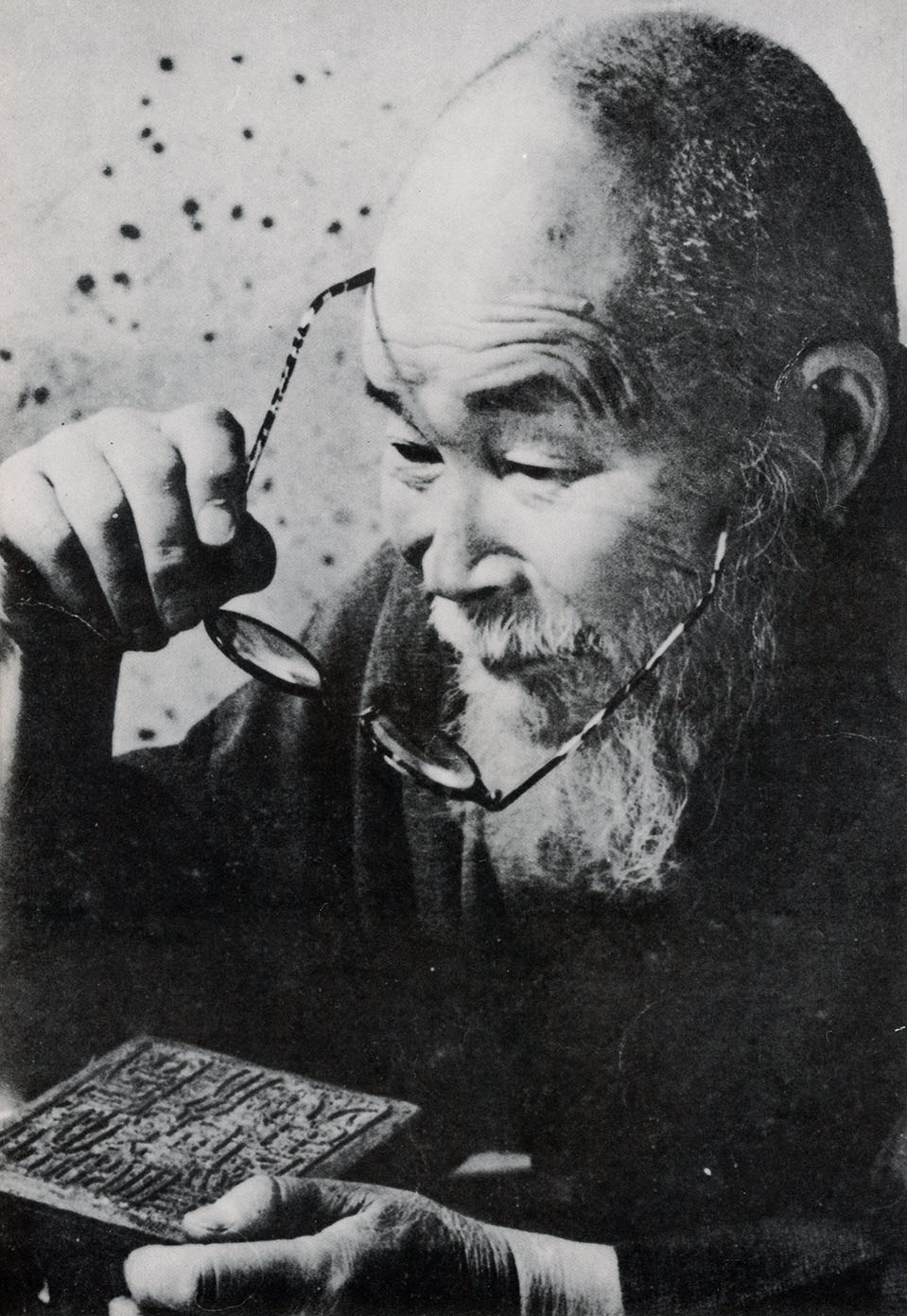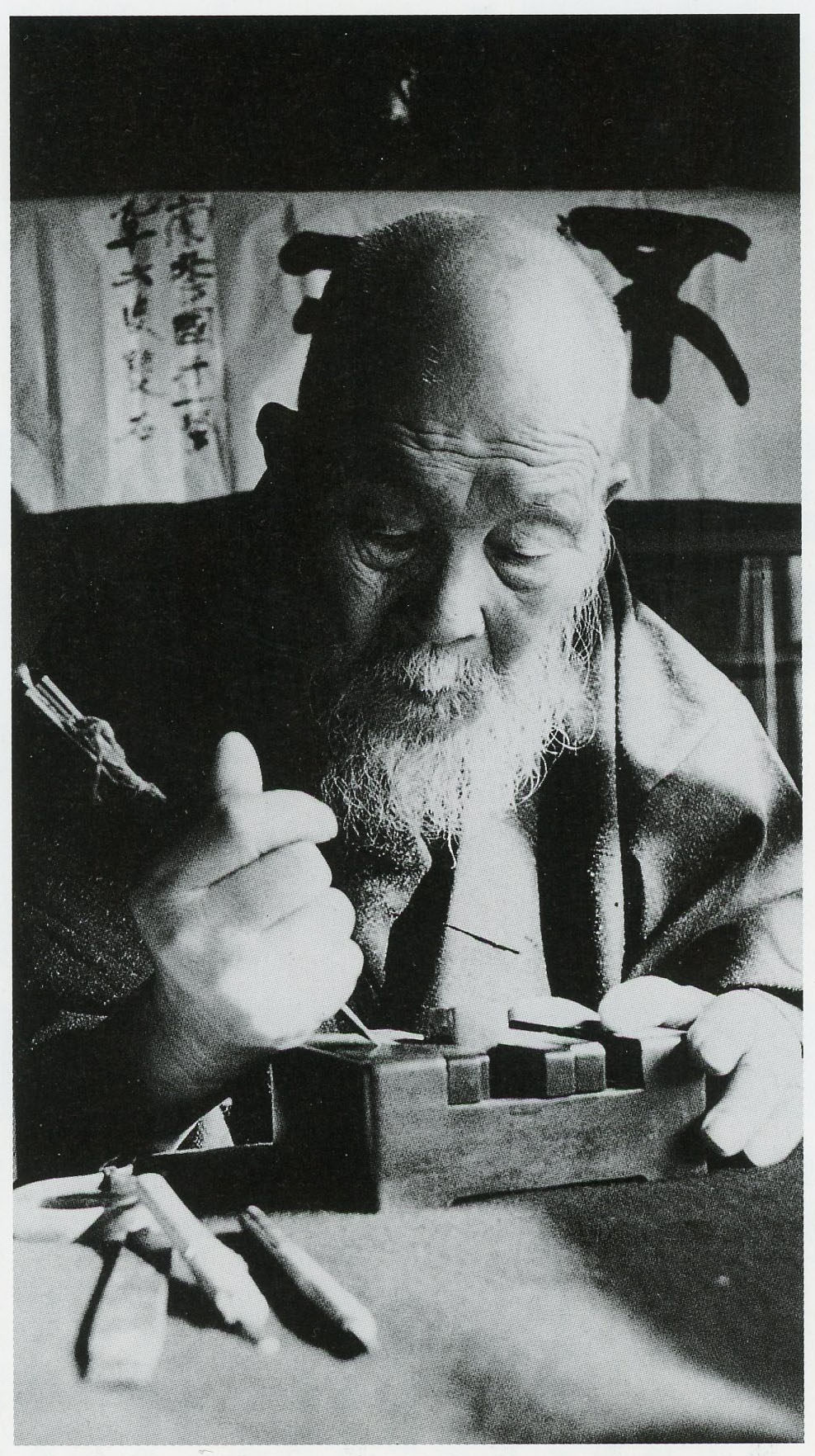
Ishii Souseki 作品を見る
On April 1, Meiji period 6 (1873), Ishii Souseki was born as the third son of Ishii Tarou Hyoue in Shitegi mura. His childhood name was Ishimatsu, and was later changed to Seki.
Some episodes are left about Ishimatsu, one of them is as follows. Since his grandmother's eyesight grew poorer as she got on in years, just three-year-old Ishimatsu put leaves twisted into a pipe for her on the large plate, lit and pass it on. Consequently, he got to smoke unintentionally. And, when he was six years old he was sent to purchase sake to offer to the gods, but drank half of it on his way home. So, he dropped in at his neighbor, Mr. Onishima, added well water to sake left and offered it to the gods. The Ishii family was related by marriage to Saitou Shirouemon (Saitou Kenseki) family who was prominent fishing boss in Kujukurihama. (Souseki's grandmother's aunt was the second wife of Saitou Kenseki.) With this background, he often visited the Saitou family since a young age, which presented many opportunities to experience writings, drawings, antiques, and other works of art firsthand, which may have led him to become a master seal engraver later on. This is written in 'Tenkoku Shinan,' "Each time I see a frame or scroll, the seals catch my eyes.
From the frame I copied Sai from Teisai, then Tou (equal to Fuji) from Fujiwara Yasutsuna in a hanging scroll, and I was finally able to create the Saitou signet." He loved detailed things since he was a small child, and never let a small dagger leave his side. Whenever he saw something rare and interesting, he immediately began to engrave it.
He studied for four years at Shitegi elementary school, then learned reading Chinese texts at kanji juku, Enshou shoin, organized by Confucian scholar Shimada Jundou, which taught him the basics of the Chinese classics.
At the age of 14 to 15, he performed secretarial duties by organizing ledgers and land ledgers at the town office where his father worked. At 16 years old he came to Tokyo. At 22 years old he joined the army where he served as a Taiwan guard in the Sino-Japanese War, then volunteered at the academy to train noncommissioned officers the following year.
In the Meiji period 39 (1906), he was a junior warrant officer in the Guard Regiment at 34 years old when he applied for the seal engraving exhibition sponsored by the Nippon Shinbun sha. On winning second place, he started training under the fifth Hamamura Zouroku, a famous seal engraving house since the Edo period, where he began learning seal engraving in earnest.
After the early death of the house master, he established the seal engraving research organization, "Choushiin kai" at 38 years old, publishing the monthly seal engraving magazine "Chouchu" along with Nashioka Sogaku and Ota Muan. The magazine was published for a total of 33 years until its discontinuation of the 341st edition in December, Shouwa period 18 (1943), covering the results of seal engraving research and working to popularize the craft.
After retiring from the army in the Meiji period 44 (1911) he was stationed in Sapporo as a civilian employee of the army where he devoted himself to the study of seal engraving on the side.
Once he left his post in the military service at 51 years of age in the Taishou period 12 (1923), Souseki moved to Harajuku, Tokyo, where he worked at Fujisan bou (its name coming from the clear view of Mt. Fuji), guiding successors and focusing all his efforts on research as a specialist. He did not neglect the fundamentals of the craft, resulting in accurate character renditions that left no room whatsoever for academic criticism.
Seal engraving is not evaluated simply by the beauty of the characters, but the quality and beauty of the materials are also important. The works of Souseki in particular show a unique strength among seal engraving in the sharp cuts.
In September of that year, a massive earthquake overturned everything on the ground in Tokyo and four prefectures of Kanagawa, Chiba, Saitama, and Shizuoka. Despite massive damage in Tokyo and Kanagawa, thankfully the family of Souseki was spared.
Souseki helped in establishing the Touhou shodou kai in the Shouwa period 6 (1931) at 59 years old, serving as its leading figure.
This association's records and collections were lost in the Tokyo air raids in the Shouwa period 20 (1945) and he evacuated to his hometown of Shitegi during the forced evacuation in May where he diligently continued engraving seals.
In the Shouwa period 22 (1947) (see p. 33), he created the seals of the University of Tokyo and its President on a request from the University.
His most representative work, "Isshou hyakuin" was completed in the Shouwa period 22 (1947). In an effort to bring even the slightest smile to the days of those suffering through poverty after the war, Souseki created 100 seals from bamboo roots and gourd calyxes with the two characters "Isshou", meaning "laugh".
In the Shouwa period 23 (1948), he relocated to Tokyo (Horikiri) where he participated in the Japan Fine Arts Exhibition (writings accepted as part 5) as a judge, then as an advisor the following year, and as a councilor in the Shouwa period 36 (1961).
Souseki's seals became famous for his superb level of skill, with requests for important official seals from all around, including the Ministry of Education and other government agencies, the Supreme Court, the Metropolitan Police Department, Meiji Jingu Shrine, and the governor of Chiba Prefecture.
Souseki was also famous as a calligrapher, writing the title on the gates of the National Diet Library in addition to leaving behind many other excellent works.

The works of Souseki have been highly praised, resulting in awarding him with the accolade of Medal with Purple Ribbon in Shouwa period 38 (1963), and the the Order of the Rising Sun, Gold Rays with Rosette in Shouwa period 40 (1965). That year he moved to Higashimatsuyama City, Saitama Prefecture.
Master seal engraver Ishii Souseki lived through the three eras of Meiji, Taisho, and Showa, surviving for a century, finally closing out his energetic life on October 29, Shouwa period 46 (1971), at the age of 99 (East Asian age reckoning).
The grand nature of Kujukurihama sometimes produces great individuals for us to look upon. The great works left behind by Souseki release their eternal sparkling light on the waves as they roll in and back out again.
→石井雙石顕彰碑